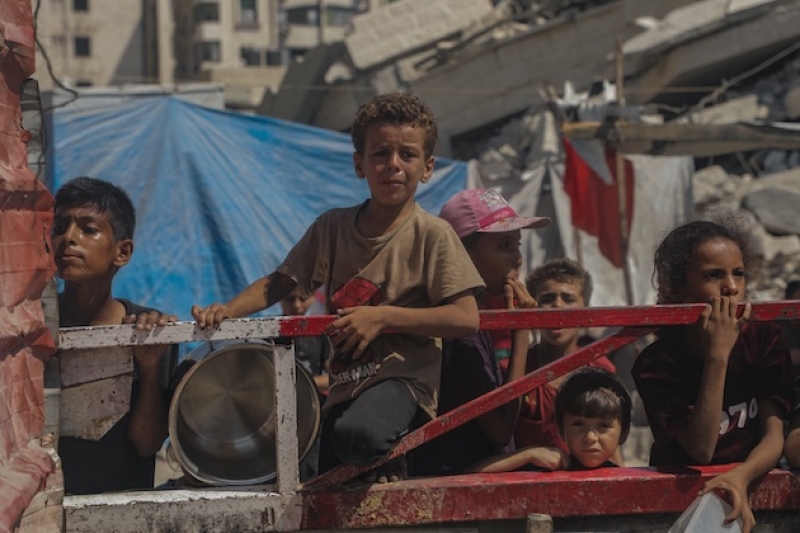- No Media Faced Arson Attacks in 53 Years: Mahfuz Anam |
- Janaza of six Bangladeshi peacekeepers held at Dhaka Cantonment |
- Bangladesh stock market loses Tk 10,500cr in a week |
- Dhaka’s air turns ‘very unhealthy’ on Sunday morning |
- Project to transform N’ganj into a climate-resilient green city |
Famine Declared in Gaza; Over 500,000 Face Starvation

The IPC confirmed famine conditions in Gaza City, Deir al Balah and Khan Younis.
The Integrated Food Security Phase Classification (IPC) has officially declared a famine in Gaza. The world’s largest food monitoring system has raised its classification to Phase 5, the highest level on its food insecurity scale.
The latest IPC analysis — the sixth on the crisis in Gaza — confirms that, as of mid-August, famine is occurring in Gaza City, and warns that by mid-September, it will expand to Deir al-Balah and Khan Younis. More than half a million Palestinians are facing “catastrophic levels” of hunger. It is estimated that by the end of September, more than 640,000 people will be enduring “catastrophic conditions” without immediate, sustained intervention. Conditions in North Gaza, home to 120,000 people, are expected to be just as severe, yet limited data on the region prevented its inclusion in the report.
The IPC declares famine when three thresholds are crossed at emergency levels: extreme food deprivation or starvation, acute malnutrition, and starvation-related deaths. This is the fifth famine confirmed by the IPC in the 21 years since it was established—and the first ever in the Middle East.
“It is a famine on all of our watch. Everyone owns this. The Gaza famine is the world’s famine,” said Tom Fletcher, UN Under-Secretary-General for Humanitarian Affairs and Emergency Relief Coordinator. “It is a famine that asks, ‘But what did you do?’ A famine that will and must haunt us all. It is predictable and preventable—a famine caused by cruelty, justified by revenge, enabled by indifference, and sustained by complicity.”
“This is a moment of collective shame,” he told reporters in Geneva on Friday. “We all have to look back as the international community and think, ‘Where could we have taken a different path?’ And we’ve watched it happen in real time.”
Major UN agencies are again calling for an immediate ceasefire and unimpeded humanitarian access into Gaza. The FAO, UNICEF, WFP, and WHO have all emphasized that “famine must be stopped.”
Representatives from FAO, UNICEF, and WFP also briefed reporters in New York on the latest IPC report. Rein Paulsen, FAO Director of the Office of Emergencies and Resilience, noted that IPC partners have been warning about worsening food insecurity in Gaza for the past 22 months due to ongoing conflict.
Among the key drivers of famine in Gaza—conflict, displacement, and restricted access to humanitarian and commercial supplies—Paulsen stressed the collapse of local food systems. He remarked that a society once self-sufficient in food production has now seen much of its infrastructure and agricultural sector decimated, leaving people “almost entirely dependent on food aid.” He added that all fishing activities have been banned, and 98.5% of croplands are either destroyed or inaccessible.
Children have become the most tragic and visible victims of the famine. Since July, at least 13,000 children are acutely malnourished, and over 112 have died from starvation. The prevalence of child malnutrition in Gaza City tripled between May and July, becoming a determining factor in the declaration of famine.
“We see malnutrition accelerating at a catastrophic pace, and for many—far too many children—it’s already too late,” said Samir Elhawary, UNICEF Acting Deputy Director of Emergency Programmes. “...It’s important to emphasize that children are starving not because food doesn’t exist, but because aid cannot reach them. They are especially vulnerable as the health system is collapsing.”
The latest IPC analysis was conducted by 50 experts across 19 organizations. UN officials emphasized that data came from a variety of sources, including partner assessments on the ground, interviews, data collection, and even measuring mid-upper arm circumference in children suspected of being malnourished.
Jean-Martin Bauer, WFP Director of Food Security and Nutrition Analysis, stressed the need to “safeguard information systems,” noting: “These systems produce the evidence we need to understand the situation and guide the humanitarian response.”
The Famine Review Committee (FRC), which acts as an independent quality control mechanism, validated the IPC analysis. According to Paulsen and Bauer, its role is to ensure the “robustness and credibility” of the findings. The FRC also released a detailed report with recommendations for reversing famine conditions, urging decision-makers and donors to "act without delay" and implement a large-scale humanitarian response to prevent further suffering from what they call an “entirely man-made catastrophe.”
“This declaration of famine is important because it quantifies a problem we've been talking about for a long time,” said Bauer.
“We hope this confirmation makes a difference,” added Paulsen. “The recommendations for practical actions to avoid further loss of life are clear in the report, and we hope there’s now greater political will to act on them.”

